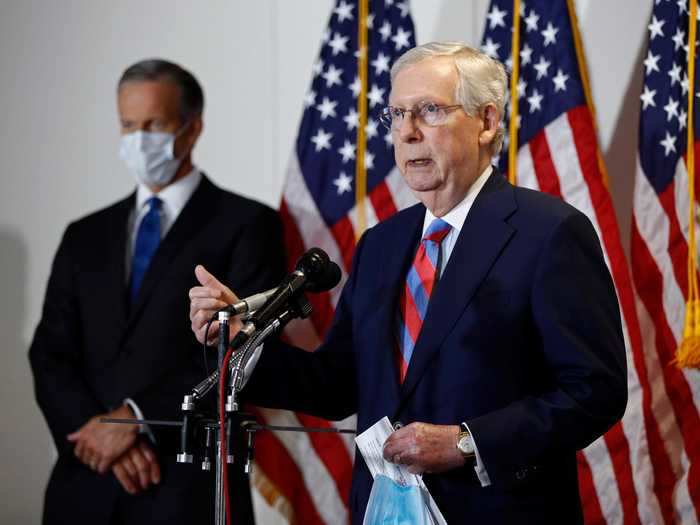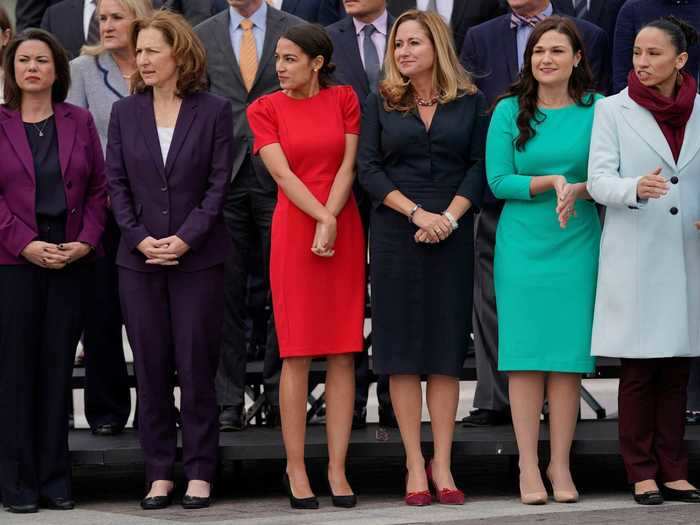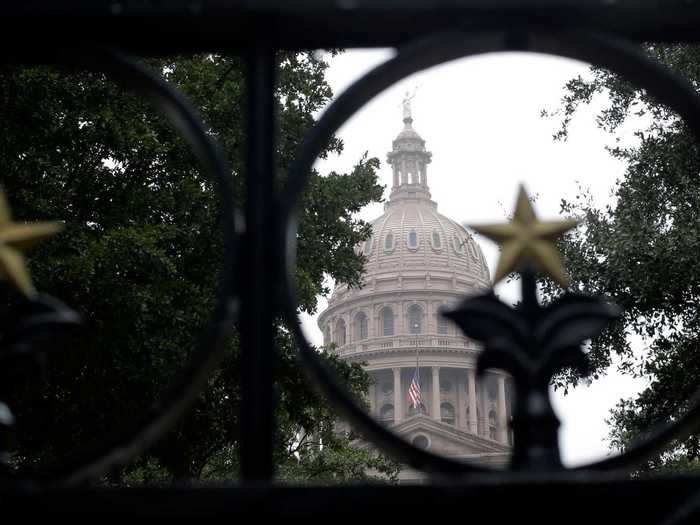Issues with testing and working remotely have complicated how Congress can operate during the coronavirus pandemic.AP Photo/Andrew Harnik
- Control of the US presidency is far from the only thing on the ballot this year.
- All 435 US House seats, 33 US Senate seats, 11 governorships, dozens of other powerful statewide offices, and thousands of legislators in 84 state legislative chambers are up for re-election this year.
- Here are the most important elections other than the presidential race you need to know about.
The high-stakes presidential contest between President Donald Trump and Vice President Joe Biden is heating up as election day looms less than six months away — but control of the presidency is far from the only thing on the ballot this year.
In addition to the battle for the White House, there are thousands of crucial US Senate, US House, state-level, and local races taking place this November that will shape the balance of power across the United States for years to come.
And in many cases, the least glamorous offices and most overlooked officials have the most power in shaping the policies that most influence Americans' lives — especially at the state level.
In addition to all 435 US House seats, there are 33 US Senate seats, 11 governorships, dozens of other powerful statewide offices including attorneys general, treasurers and auditors, and thousands of legislators in 84 state legislative chambers up for re-election this year.
Control over the US Congress will be essential for both parties either to pass — or thwart — the next president's legislative agenda, including federal coronavirus recovery initiatives.
At the state level, the dozens of statewide officials and state legislators, who introduce, pass, and implement far more legislation than Congress, will help decide how their states combat the COVID-19 outbreak and recover economically from the crisis.
Here are the most important elections other than the presidential race you need to know about:
Read the original article on
Business Insider
US Senate
Senate Majority Leader Mitch McConnell of Ky., speaks at a news conference on Capitol Hill in Washington, Tuesday, May 12, 2020. Standing behind McConnell is Senate Majority Whip John Thune, R-S.D. (AP Photo/Patrick Semansky)
Associated Press
In the 2018 midterms, Republicans netted two seats in the US Senate, expanding their majority to a 53-47 lead (the Senate has 45 Democrats and two independents who caucus with Democrats), and consolidated Majority Leader Mitch McConnell's power over the body.
Accounting for a likely loss of a seat in Alabama, Democrats will need to recapture five seats (four if Biden wins the presidency) to win back control of the chamber.
If Biden is elected president, he'll need a Democratic-controlled US Senate — and McConnell in the minority — to have any hope of passing any of his legislative priorities, including the kind of sweeping policy changes his team is eyeing as part of a coronavirus recovery package.
Winning back the Senate will be no easy feat. But both Trump's declining favorability and the severe economic crisis caused by the COVID-19 pandemic has vastly expanded the Senate map for Democrats and put a number of previously out of reach seats in play, as Insider's Eliza Relman recently reported.
Most vulnerable Democrat:
- Sen. Doug Jones of Alabama achieved the unthinkable by winning a special election against controversial and scandal-plagued Judge Roy Moore in 2017. But he'll face a much tougher go this fall either against former Sen. Jeff Sessions or former Auburn football coach Tommy Tuberville with presidential-level turnout and President Donald Trump at the top of the ticket.
Most vulnerable Republican seats:
- Sen. Cory Gardner of Colorado, a close Trump ally running for re-election in a state that has a rapidly swung from purple to reliably blue against former two-term Governor John Hickenlooper, is widely considered the most vulnerable Senate Republican.
- Sen. Martha McSally of Arizona was appointed to serve in former Sen. John McCain's seat after losing the election for Arizona's other US Senate seat to Democrat Krysten Sinema. She faces a tough battle to be elected to a full term against Mark Kelly, an astronaut and gun violence prevention activist, who has proven himself to be a fundraising juggernaut.
- Sen. Susan Collins of Maine. Once lauded for her independence, her popularity has declined thanks to her association with Trump and some of her more controversial votes. Her likely Democratic opponent, Maine House Speaker Sara Gideon, is amassing an impressive war chest of campaign funds.
- Sen. Thom Tillis of North Carolina, a once solidly-Republican state that is trending purple and is set to be highly competitive in the electoral college this year. As Tillis tries to balance working with the state's Democratic governor on helping the state recover while also remaining in good standing with Trump, a number of recent polls have shown Democratic nominee Cal Cunningham either leading or within single digits of him.
- Sen. Steve Daines of Montana, who faces a formidable opponent in popular two-term Democratic Governor and former presidential candidate Steve Bullock.
- Sen. Joni Ernst of Iowa, a state whose agriculture sector has been particularly hard-hit by the COVID-19 pandemic. While Iowa has been trending Republican for several cycles, the current economic disaster could put the state back in play for statewide Democrats, with recent polls showing Democratic candidates Teresa Greenfield and Eddie Mauro within striking distance of Ernst.
- The open Republican-held seat in Kansas, being vacated this year by Sen. Pat Roberts. Kris Kobach, a controversial candidate who lost the 2018 Governor's race to Democrat Laura Kelly, is running in the GOP primary to replace Roberts.
- There's a double-barrel US Senate election this November in Georgia, where a spate of recent polling, including GOP internal polls, has shown Republicans more vulnerable than ever.
- Sen. David Purdue is up for re-election. And Sen. Kelly Loeffler, who was appointed to fill out the rest of Sen. Jonny Isaakson's term and became embattled in controversy over her stock sales, will compete in a top-two special election with fellow Republican Rep. Doug Collins and Democrat Raphael Warnock.
- As of now, both seats are likely to remain in Republican hands. But especially given the dismal polling numbers Georgia Republicans have seen, Democrats are still investing in the state to expand their margins and show they can make the state competitive.
US House of Representatives
Reps Angie Craig of Minnesota, Kim Schrier of Washington, Alexandria Ocasio Cortez of New York, Debbie Mucrasel-Powell of Florida, Abby Finkenauer of Iowa, and Sharice Davids of Kansas, all elected in 2018.
AP Photo/Pablo Martinez Monsivais
Democrats pulled off a huge victory in the House in the 2018 midterm elections, flipping 40 previously GOP-held House seats and allowing Democrats to both pursue important legislative initiatives and impeach Trump.
There are currently 234 Democrats, 198 Republicans, one Libertarian, and two vacancies (both in safe Republican seats) in the House, meaning that Republicans will need to win back 20 seats to re-capture the majority this year.
In addition to the national environment becoming more difficult for Republicans as the coronavirus crisis drags on, the GOP has failed to recruit high-quality challengers to go up against many of the freshman Democrats who flipped competitive seats in 2018 or match them in fundraising.
Because of those structural factors, most analysts say that Republicans are unlikely to win back the chamber altogether. But there are still plenty of competitive seats on the table that present opportunities for both parties.
Here's a look at some of the most competitive Democratic and Republican-held seats in the House of Representatives — listed in no particular order — according to experts at the Cook Political Report and Sabato's Crystal Ball at the University of Virginia Center for Politics.
Most vulnerable Democrats:
- Rep. Collin Peterson of Minnesota's 7th congressional district, which Trump won by 30 percentage points in 2016.
- Rep. Anthony Brindisi of New York's 22nd district in the Syracuse area.
- Rep. Kendra Horn of Oklahoma's fifth district, which Trump won by 13 percentage points
- Rep. Joe Cunningham of South Carolina's first district, which Trump won by 13 percentage points
- Rep. Jared Golden of Maine's second congressional district, which Trump carried by nearly eleven percentage points in 2016.
- Rep. Xochitl Torres-Small of New Mexico's second district.
- Rep Max Rose of New York's 11th congressional district.
- Rep. Ben McAdams of Utah's fourth congressional district.
- Rep. Elaine Luria of Virginia's second congressional district.
- Rep. Abigail Spanberger of Virginia's seventh district.
- Rep. Lucy McBath of Georgia's sixth district.
- Rep. Andy Kim of New Jersey's third district.
- Rep. TJ Cox of California's 21st congressional district.
- Rep. Abby Finkenauer of Iowa's 1st congressional district.
- Iowa's second congressional district, represented by retiring Democratic Rep. Dave Loebsack.
Most vulnerable Republican seats:
- Texas' Republican-held 23rd congressional district, which former Senate candidate Beto O'Rourke carried by five points in 2018, currently held by retiring Rep. Will Hurd.
- Texas' 22nd congressional district in the Houston suburbs, a diverse and Democratic-trending seat held by retiring GOP Rep. Pete Olson.
- Texas' 24th congressional district in the Dallas-Fort Worth suburbs, held by retiring Rep. Kenny Marchant, that has also been trending Democratic in recent years.
- Georgia's 7th congressional district in the fast-growing Atlanta suburbs and exurbs, vacated by retiring Rep. Rob Woodall, who narrowly won re-election by under 500 votes in 2018.
- Nebraska's 2nd congressional district, which encompasses Omaha and the surrounding suburbs. Rep. Don Bacon is facing a re-match against Kara Eastman, who came within two points of defeating him in 2018.
- California's 25th congressional district, which Republican Mike Garcia just won back for the GOP in a special election to replace Democrat Katie Hill. While Garcia proved himself to be a strong candidate, he may face a tougher race in the fall.
- Rep. Jeff Van Drew of New Jersey's 2nd congressional district, who dramatically switched parties in late 2019 after winning back the seat for Democrats in the 2018 midterms. Van Drew, whose decision angered those on both sides of the aisle, now faces primary challengers from within the GOP and a number of Democrats lining up to defeat him.
- Rep. Rodney Davis of Illinois' 13th congressional district will face a re-match against Democratic candidate Betsy Londrigan, who he beat by less than a one-point margin in 2018.
Governors and other statewide officials
North Carolina Gov. Roy Cooper
Jonathan Drake/Reuters
There are 11 Governors up for re-election in 2020, but just two competitive races.
In Montana, where current Gov. Steve Bullock is terming out, there will be a highly contested race, which the Cook Political Report rates as a toss-up.
Current GOP Rep. Greg Gianforte, who currently represents the state's at-large congressional district, Attorney General Tim Fox, and State Senator Albert Olszewski are vying for the Republican nomination while Lt. Governor Mike Cooney and non-profit leader Whitney Williams are competing for the Democratic nomination in the state's June 2 primary.
Democratic Gov. Roy Cooper is also up for re-election in North Carolina, which is set to be a crucial battleground in the electoral college, against GOP Lt. Governor Dan Forest, who is considered a much weaker candidate than Cooper.
In addition to the gubernatorial elections, there are nine lieutenant gubernatorial elections, 10 attorney general elections, and dozens of other races for powerful statewide officials including secretaries of state, treasurers, auditors, education officials, and more in 28 states, according to Ballotpedia.
State legislatures
Eric Gay/AP
The vast majority of most US policymaking takes place in state legislative chambers, which,w whille often overlooked, have come under the spotlight during the current pandemic.
This year, control of 86 state legislative chambers and thousands of seats in 43 states will be on the ballot. These bodies will tackle not only the response and recovery to the coronavirus crisis, but also the redistricting of congressional and state legislative district boundaries after the 2020 census.
While Republicans have dominated state legislative politics for decades, Democrats have started to gain back some ground, winning back 400 seats since the 2016 election. As of 2020, Republicans control 52% of state legislative seats and 60% of state legislative chambers, according to the National Conference of State Legislatures.
These are the main legislative chambers Democrats are aiming to flip and Republicans are hoping to hold this year, several Democratic and Republican strategists working on state legislative races told Insider:
- Both chambers of the Arizona legislature. Democrats need to win back two seats to gain control of the Arizona House of Representatives and three seats to win back the Arizona State Senate.
- Both chambers of the North Carolina General Assembly. Democrats need six seats to win back the North Carolina House of Representatives and five seats to win back the North Carolina State Senate.
- Both chambers of the Pennsylvania General Assembly. Democrats need to win nine seats to control the Pennsylvania House and four seats to control the Pennsylvania Senate.
- The Minnesota State Senate, which Democrats need to win back only two seats to control.
- The Michigan House, which Democrats need to win back four seats to control.
- The Texas House, which Democrats need to win nine seats in order to flip.
- The Iowa House, which Democrats need to win back four seats to control.




